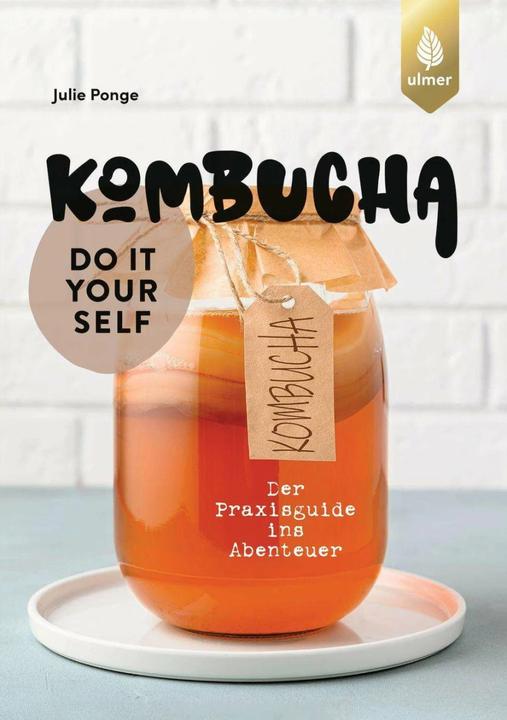

Tea, sugar and a SCOBY – how to brew kombucha
Tea, sugar and a slimy blob, known as a SCOBY, are the starting ingredients for my first fermented home brew, kombucha.
It all started with a slimy blob in yellowish liquid. My sister, who’d got into the art of Kombucha brewing some time ago, gifted me a SCOBY. My very first home brewing experience!
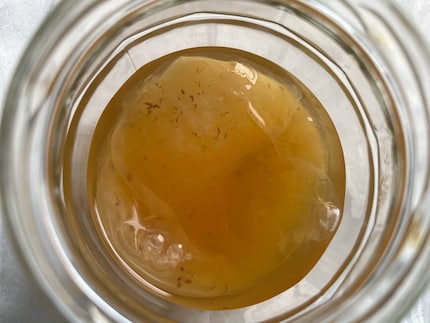
Source: Anna Sandner
SCOBY, the slimy blob
Given how it looks, ingesting the SCOBY would be the last thing on my mind. The jiggly slimeball is more reminiscent of my lab course in microbiology. Indeed, it wouldn’t be out of place there at all; SCOBY stands for «symbiotic culture of bacteria and yeast».

Unfortunately, the SCOBY starter set above is currently only available in our Swiss shop.
To keep my SCOBY in good shape while I read up on the art of brewing, I store it in a jar in my fridge.
Here’s what kombucha looks like under the microscope:
From sweetened tea to carbonated soft drink
I start by doing some background research. Several fermentation processes are involved in the production of kombucha. First, there’s yeast, which converts sugar into alcohol. Next, bacteria set about metabolising this alcohol, creating acetic acid, gluconic acid, glucuronic acid and other substances in the process. The longer the SCOBY is at work, the more acidic the kombucha becomes.
Armed with step-by-step instructions from my sister, it’s time to get brewing!
Unfortunately, the books above are currently only available in our Swiss shop.
First fermentation: feeding the SCOBY
The first challenge is to find a glass carafe large enough for the batch. Plastic and metal aren’t recommended; unwanted substances may get into the drink and disturb fermentation.
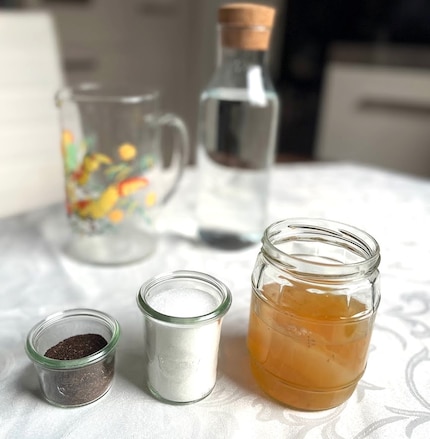
Source: Anna Sandner
Here’s what I put in my carafe:
- SCOBY with 200 ml of starter liquid (that is, «old» kombucha in which the SCOBY is stored)
- 12 g unflavoured green or black tea (I went for black)
- 100 g sugar
- 1.3 L water
First, brew a tea concentrate with 300 ml of water and dissolve the sugar in it. Pour the sweetened tea and a litre of water into the carafe and add the SCOBY and starter liquid. Stir everything well, fasten a kitchen towel around the opening with a rubber band – and now the waiting game begins. I took great care to work hygienically at every stage. I don’t want my SCOBY to have any unwanted foreign competition.
Leave the mixture to ferment for eight days in an undisturbed corner of the kitchen. It’s important you make sure it’s not too cold, or the bacteria and yeast won’t be active. It should be at least 19 degrees during fermentation.
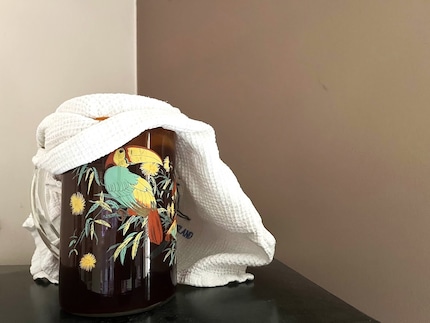
Source: Anna Sandner
8 days later: and then there was kombucha
On day 8, I was as excited as a child on Christmas morning. Did my kombucha ferment? Is it any good? What does it look like? I’m so excited!
At first glance, it doesn’t look much different than it did a week ago. I do a quick taste test to see if I like my brew or if I want to leave it a while longer to become more acidic. I’m very happy with the taste!
After removing the towel, I transfer the SCOBY, which has grown, along with some of the brew (this will be the new starter liquid) back into the old pickle jar I got it in. This goes straight in the fridge to prevent further fermentation. Now, I pour my home brew through a sieve into bottles with screw caps. I filter it so that no remaining parts of the SCOBY end up in the bottle.
I’m not going to lie, I’m already thrilled with my kombucha!
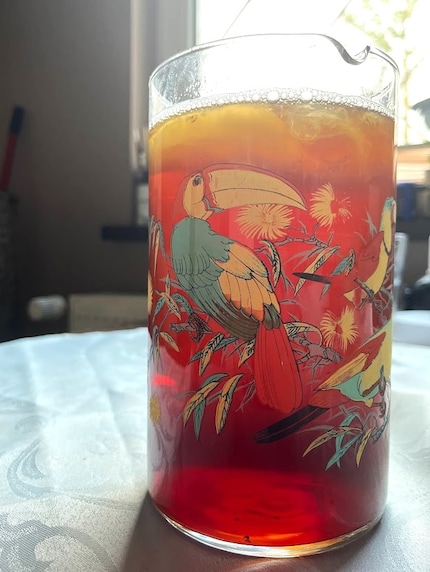
Source: Anna Sandner
It’s much tastier than the store-bought kombucha I’ve had. Of course, this must be down to my incredible brewing skills! Or maybe I’m just overjoyed that it worked at all… Disclaimer: the taste of kombucha is quite unique, and certainly not everyone’s cup of tea. You have to like the special note created by the fermentation process.
Done – or not quite?
So far, so good. I’m happy with my result, but not quite finished yet. Now comes the second round of fermentation. This time around, the goal is to create and keep carbon dioxide in the drink. You can also refine your basic Kombucha with flavourings such as herbs, fruit or spices.
I opt for a citrus version and add a few slices of lemon to a portion of my kombucha in a sealable bottle. Bottles with a screw cap or swing top are suitable. Important: let the carbon dioxide out of the bottles at least once a day so that they don’t explode.
I now leave my lemon kombucha to ferment at room temperature for a few more days.
After four days, it’s ready. Keep in mind that this second round of fermentation is optional.
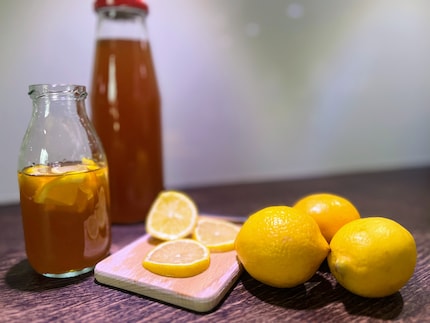
Source: Anna Sandner
My verdict: less effort than expected
Overall, I’m very happy with my kombucha. It was less complicated and time-consuming than I’d expected. It was also fun to make, and a great source of pride.
Finally, I did also look into the health effects of kombucha.
What are the health benefits of kombucha?
Hop on the internet and you’ll quickly come across a whole host of promised health benefits of kombucha. Kombucha is said to promote intestinal health, activate the immune system and be good for the skin, blood and metabolism. Sounds great, sure.
But a quick search in scientific databases quickly dispels any hope of kombucha being an all-encompassing miracle cure. Unfortunately, these promised health benefits have yet to be scientifically proven in humans. A systematic review from 2019 on the health effects of kombucha found just one uncontrolled empirical human subjects study examining the effects of kombucha on health or health-related outcomes, and no controlled studies. The health claims are based on anecdotes, results of laboratory studies and experiments with animals.
Mind you, this doesn’t necessarily mean that the health claims can’t be true – after all, they haven’t been refuted. But they haven’t been confirmed either, meaning they remain mere conjecture. Especially as there are also indications of side effects such as allergic reactions or nausea, kombucha should be consumed in moderation. But hey, this way it stays something special to be enjoyed all the more!
In my «I did it!» series, I try to get into the habit of new routines. Most recently, I drank a different tea every day for a week and concluded that I most likely will never be a regular tea drinker. With my own kombucha, perhaps that’ll change after all.
Header image: Anna Sandner
Science editor and biologist. I love animals and am fascinated by plants, their abilities and everything you can do with them. That's why my favourite place is always the outdoors - somewhere in nature, preferably in my wild garden.
Practical solutions for everyday problems with technology, household hacks and much more.
Show all

